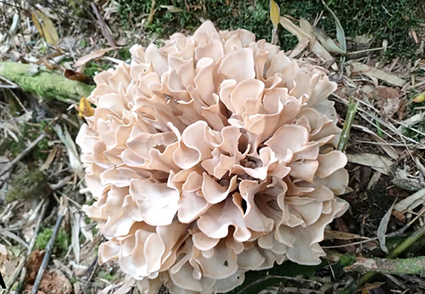Abstract
Sparassis fanjingshanensis is described as a new species of Sparassidaceae based on morphology and phylogenetic analyses in this study. It was found in Abies fanjingshanensis community of the massy dwarf forest to Fanjing Mountain, China, and this is the only site of its occurrence known to date. Phylogenetic analysis of the sequences based on the internal transcribed spacer (ITS), the nuclear ribosomal large subunit (LSU) and partial gene coding RNA polymerase subunit II (rpb2) indicated that Sparassis fanjingshanensis belonged to the genus Sparassis and it formed a novel monophyletic clade next to Sparassis subalpina. Sparassis fanjingshanensis can be distinctly distinguished by its large basidiomata and light-gray to light-khaki flabellae that is compactly arranged, entire, broadly spathulate, slightly contorted, surface glabrous, top margin undulate, smooth, stem with concentric ring ornamentation (similar to the annual rings of a tree). In total, up to now, four taxa have been found in East Asia: Sparassis cystidiosa f. labelliformis, Sparassis fanjingshanensis, Sparassis labelliformis and Sparassis subalpine.
References
- Blanco-Dios, J.B., Wang, Z., Binder, M. & Hibbett, D.S. (2006) A new Sparassis species from Spain described using morphological and molecular data. Mycological Research 10: 1227–1231. https://doi.org/10.1016/j.mycres.2006.07.012
- Dai, Y.C., Wang, Z., Binder, M. & Hibbett, D.S. (2006) Phylogeny and a new species of Sparassis (Polyporales, Basidiomycota): evidence from mitochondrial atp6, nuclear rDNA and rpb2 genes. Mycologia 98: 584–592. https://doi.org/10.3852/mycologia.98.4.584
- Desjardin, D.E., Wang, Z., Binder, M. & Hibbett, D.S. (2004) Sparassis cystidiosa sp. nov., from Thailand is described using morphological and molecular data. Mycologia 96: 1010–1014. https://doi.org/10.1080/15572536.2005.11832901
- Dong, C.H. & Ma, Q.Q. (2014) Advances in the Study of Sparassis Species, Precious Edible Mushrooms. Mycological Research 12 (3): 172–177.
- Kalyaanamoorthy, S., Minh, B.Q., Wong, T.K.F., Von Haeseler, A. & Jermiin, L.S. (2017) ModelFinder: fast model selection for accurate phylogenetic estimates. Nature Methods 14: 587–589. https://doi.org/10.1038/nmeth.4285
- Li, Y.C., Feng, B. & Yang, Z.L. (2011) Zangia, a new genus of Boletaceae supported by molecular and morphological evidence. Fungal Diversity 49: 125–143. https://doi.org/10.1007/s13225-011-0096-y
- Lv, Y., Xiong, K.N., Rong, L., Chen, H., Gao, Y. & Ying, B. (2016) Comparative analysis of the World Natural Heritage value of the bioecological evolution of Fanjing Mountain. World Geography Research 25 (5): 131–141. https://doi.org/10.3969/j.issn.1004-9479.2016.05.014
- Miller, M.A., Pfeiffer, W. & Schwartz, T. (2010) Creating the CIPRES Science Gateway for inference of large phylogenetic trees. In: 2010 Gateway Computing Environments Workshop (GCE). New Orleans, LA, pp. 1–8. https://doi.org/10.1109/GCE.2010.5676129
- Mao, W.L., Wu, Y.D., Liu, H.G., Yuan, Y. & Dai, Y.C. (2023) A contribution to Porogramme (Polyporaceae, Agaricomycetes) and related genera. IMA fungus 14: 5. https://doi.org/10.1186/s43008-023-00110-z
- Merwe, B.V., Herrmann, P. & Jacobs, K. (2023) Hericium ophelieae sp. nov., a novel species of Hericium (Basidiomycota: Russulales, Hericiaceae) from the Southern Afrotemperate forests of South Africa, Mycology 14 (2): 133–141. https://doi.org/10.1080/21501203.2023.2191636
- Petersen, R.H., Jan, B., Segovia, A.R. & Hughes, K.W. (2015) Transatlantic disjunction in fleshy fungi. II. The Sparassis spathulata – S. brevipes complex. Mycological Progress 14: 30. https://doi.org/10.1007/s11557-015-1049-8
- Stamatakis, A. (2014) RAxML version 8: a tool for phylogenetic analysis and post-analysis of large phylogenies. Bioinformatics 30 (9): 1312–1313. https://doi.org/10.1093/bioinformatics/btu033.pmid:24451623
- Sudhir, K., Glen, S. & Koichiro, T. (2016) MEGA7: Molecular Evolutionary Genetics Analysis Version 7.0 for Bigger Datasets. Molecular Biology & Evolution 33 (7): 1870–1874. https://doi.org/10.1093/molbev/msw054
- Wang, Z., Binder, M., Dai, Y.C. & Hibbett, D.S. (2004) Phylogenetic relationships of Sparassis inferred from nuclear and mitochondrial ribosomal DNA and RNA polymerase sequences. Mycologia 95: 1008–1012. https://doi.org/10.2307/3762086
- Yuan, Y., Bian, L.S., Wu, Y.D., Chen, J.J., Wu, F., Liu, H.G., Zeng, G.Y. & Dai, Y.C. (2023) Species diversity of pathogenic wood-rotting fungi (Agaricomycetes, Basidiomycota) in China. Mycology 14: 204–226. https://doi.org/10.1080/21501203.2023.2238779
- Zeng, N.K., Tang, L.P., Li, Y.C., Tolgor, B., Zhu, X.T., Zhao, Q. & Yang, Z.L. (2013) The genus Phylloporus (Boletaceae, Boletales) from China: morphological and multilocus DNA sequence analyses. Fungal Diversity 58: 73–101. https://doi.org/10.1007/s13225-012-0184-7
- Zhang, D., Gao, F. & Jakovlić, I. (2020) PhyloSuite: an integrated and scalable desktop platform for streamlined molecular sequence data management and evolutionary phylogenetics studies. Molecular ecology resources 20 (1): 348–355. https://doi.org/10.1111/1755-0998.13096
- Zhang, Q.Y., Liu, H.G., Papp, V., Zhou, M., Dai, Y.C. & Yuan, Y. (2023) New insights into the classification and evolution of Favolaschia (Agaricales, Basidiomycota) and its potential distribution, with descriptions of eight new species. Mycosphere 14: 777–814. https://doi.org/10.5943/mycosphere/14/1/10
- Zhao, Q., Feng, B. & Yang, Z.L. (2013) New species and distinctive geographical divergences of the genus Sparassis (Basidiomycota): evidence from morphological and molecular data. Mycological Progress 12 (2): 445–454. https://doi.org/10.1007/s11557-012-0853-7
- Zhao, H., Dai, Y.C., Wu, F., Liu, X.Y., Maurice, S., Krutovsky, K.V., Pavlov, I.N., Lindner, D.L., Martin, F.M. & Yuan, Y. (2023) Insights into the ecological diversification of the Hymenochaetales based on comparative genomics and phylogenomics. Genome Biology and Evolution 15 (8): 1–15. https://doi.org/10.1093/gbe/evad136
- Zheng, W., Binder, M. & Hibbett, D. (2004) Phylogenetic relationships of Sparassis inferred from nuclear and mitochondrial ribosomal DNA and RNA polymerase sequences. Mycologia 96 (5): 1015–1029. https://doi.org/10.1080/15572536.2005.11832902
- Zhou, M., Dai, Y.C., Vlasák, J., Liu, H.G. & Yuan, Y. (2023) Updated systematics of Trichaptum s.l. (Hymenochaetales, Basidiomycota). Mycosphere 14: 815–917. https://doi.org/10.5943/mycosphere/14/1/11
- Zhu, S.Q. & Yang, Y.Q. (1987) Preliminary study on moss dwarf forest on the summit of Fanjing Mountain. Guizhou. Journal of Plant Ecology and Geobotany 2: 92–105. https://doi.org/CNKI:SUN:ZWSB.0.1987-02-001


